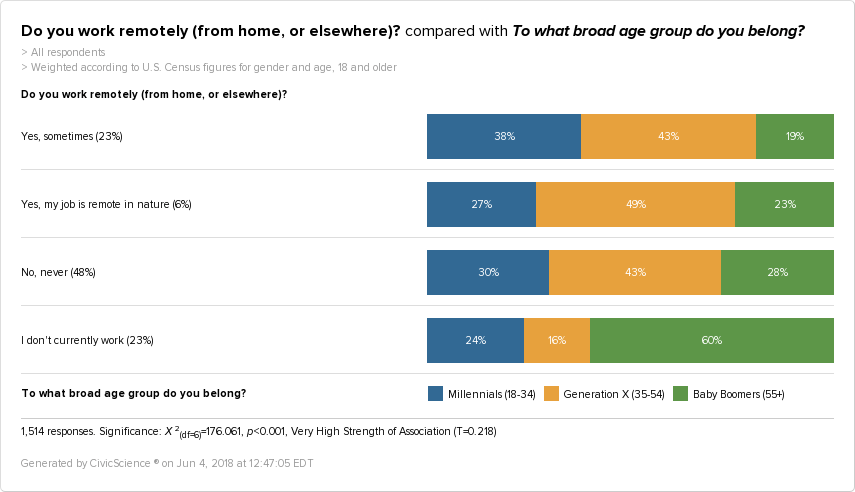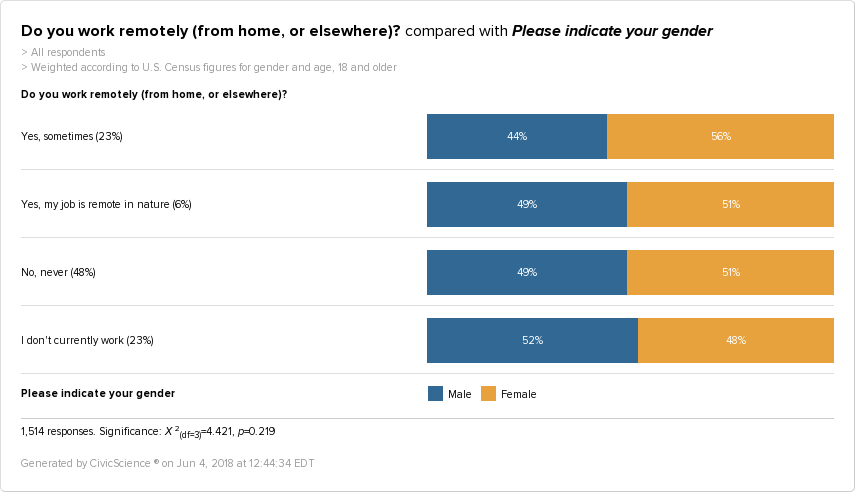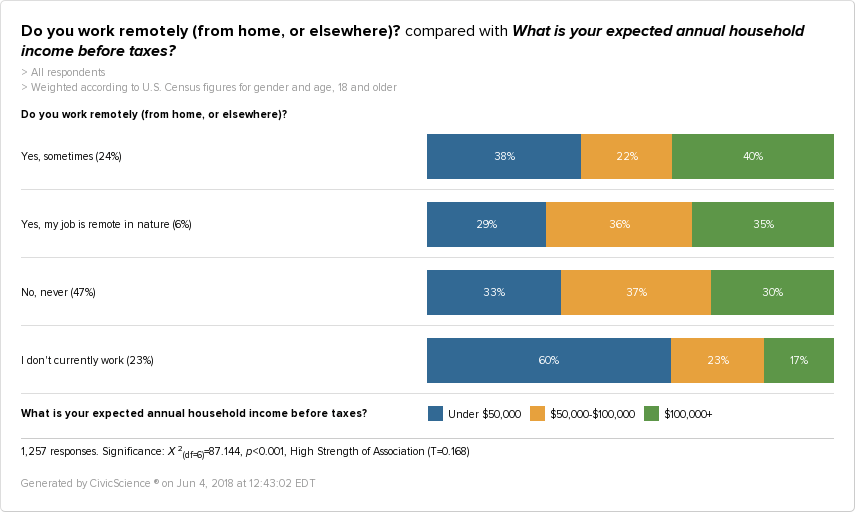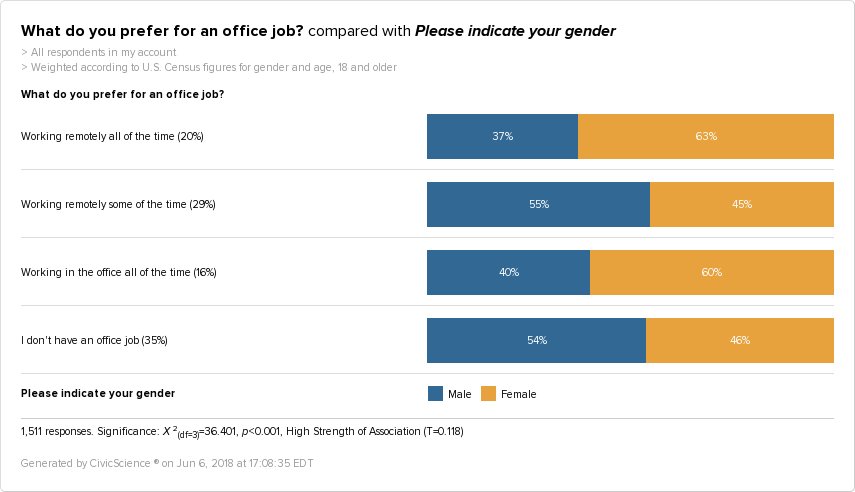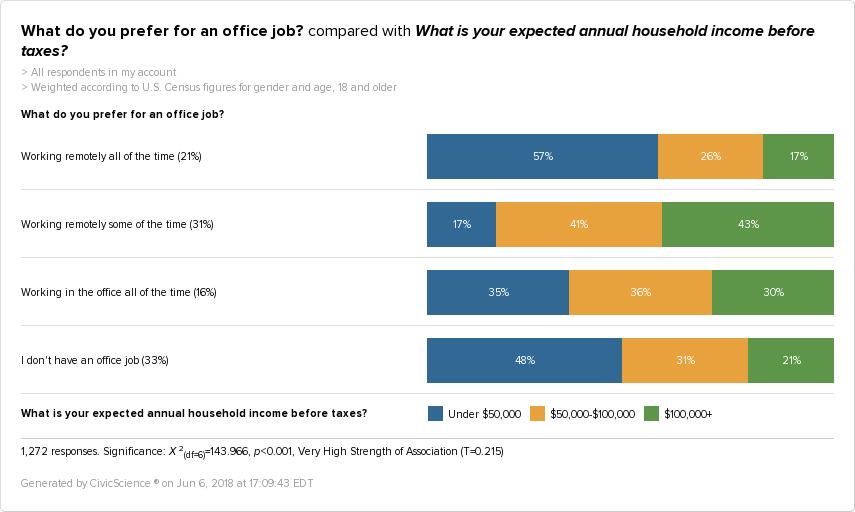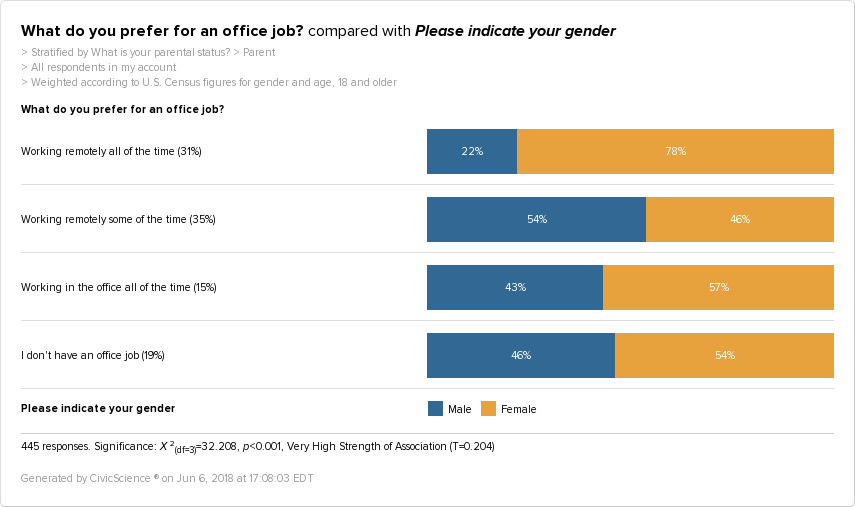The Gist: Currently, the remote workforce comprises of income earners from the highest and lowest ends of the spectrum. However, interest from moms, Millennials, and unattached men could indicate that the face of remote work may be primed for change.
It is no secret that the job market is changing. With the rise of the side hustle and the impact of tech, the way we work today looks far different than it did even twenty years ago. In some cases, entire companies have been built upon the backs of a remote or distributed workforce, with employees interacting across the globe. Even those companies that are not yet embracing a totally remote approach seem to be more lenient with employees working from home on an occasional basis. So, all of this got us thinking, what do employees really want?—
We started by asking respondents their experience with working from home.
 Although 48% never work from home, 23% of US adults sometimes work remotely, and 6% say their job is remote in nature. When we combine our remote workers together, this means that almost one-third of US adults (29%) work remotely, at least some of the time.
Although 48% never work from home, 23% of US adults sometimes work remotely, and 6% say their job is remote in nature. When we combine our remote workers together, this means that almost one-third of US adults (29%) work remotely, at least some of the time.
We dug further to see how age played a role and discovered that Gen Xers are leading the way in the occasional work from home category, with 43% of those who sometimes work from home falling between the ages of 35 and 54. However, Millennials, at 38% are not too far behind.
Although not the majority, we should note that 27% of those who say their job is remote in nature are Millennials, showing a sustained interest from the youngest in the workforce, to define their own roles.
And, as we discovered, the current remote workforce is split fairly evenly along gender lines.
56% of those who sometimes work from home are female. However, in the rest of the categories, the percentages of men and women hover around the 50/50 mark, making remote workers a truly diverse crowd. Does this diversity continue into income levels? Let’s find out.
As the data shows, remote work appears to be split between the most affluent and the least, with 40% of those who sometimes work remotely earning more than $100k a year and 38% earning less than $50k. Who knew remote work could be so financially polarizing? Could it be that working remotely is both a luxury and a necessity?
One reason an individual might choose to work from home is to take care of other responsibilities, like children. So how does parental status fit in? Here, we can see that the data does differ by gender and parental status.
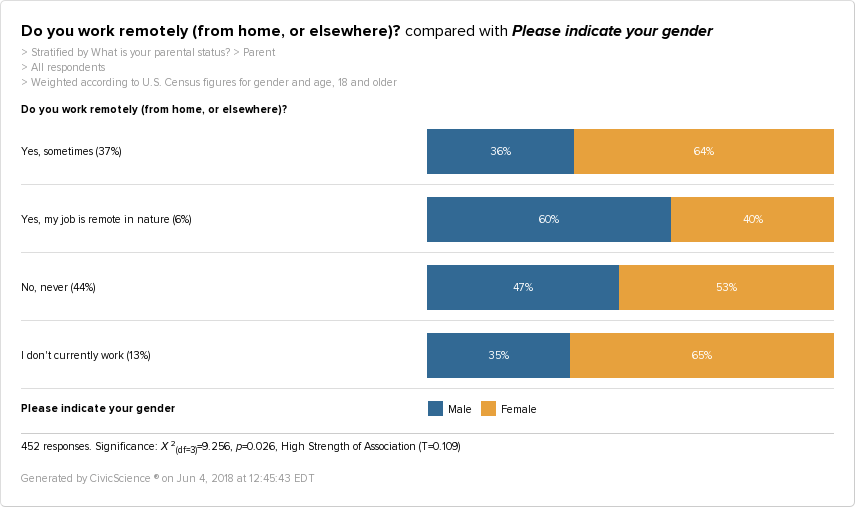
64% of women who are mothers say they work remotely sometimes, while 60% of men who are fathers say their job is remote in nature. This balance could make it more convenient to share the duties of parenting since these different roles could complement each other. As for those who are not parents, the results are clear.
Women who are neither parents nor grandparents are by far more likely to say their job is remote in nature than their male counterparts. Perhaps, in this case, the lack of distraction at home makes it easier for these less attached women to actually get work done? That may just be speculation, but it is something to consider.
So what does all of this say about work environment and office culture? Since reality and preference are two different things, we asked our respondents what they would prefer in an office job when it comes to remote work.

What we found is that interest in, and preference for remote work is strong. While 29% would prefer working remotely some of the time, a healthy 20% would prefer working remotely all of the time. And you know what? Only 16% of respondents would prefer working in an office all of the time. This is what that data looks like simplified.
Here, we can see even more clearly that over ⅔ of US adults would prefer to work at least some of the time remotely. Employers should take note, as this preference could cause top talent to go elsewhere if the perks involve working outside of the office.
So, who exactly is looking for these remote opportunities? Well, as you may or may not have guessed, Millennials outweigh every other generation in the desire to work all of the time remotely. In fact, 56% of those who would rather never go into an office are Millennials.

Gen Xers make up 56% of those who would like to work some of the time remotely, while Baby Boomers are the largest percentage of those who prefer working in an office all of the time. So, if you were wondering whether the remote work craze is divided along generational lines, the answer is a resounding yes.
Things get more complicated when we take a look at remote work preference and gender.
Although women make up 63% of those who would prefer to work all of the time remotely, men make up 55% of those who would prefer to work some of the time remotely. And our office lovers? Well, they are overwhelmingly women, with 60% preferring the traditional office route.
There is a lot to unpack here, not the least of which is the discrepancy between who currently works remotely (primarily men) and who wants to work remotely (primarily women). The nuance here is that men want the freedom of being able to work remotely only some of the time, while women are interested in having that freedom as a permanent perk. Could family responsibilities or life stage influence some of these answers? It’s not out of the question.
Of course, we wanted to take another look at income levels. In doing so, we confirmed, once again, that reality and ideal are two very different animals. Remember how the majority of those who worked remotely were our highest income earners, those pulling in over $100k a year? Well, take a look at who wants to be working from home.
Those who earn less than $50k a year comprise 58% of US adults who want to work all of the time remotely. This could be related to the widespread interest in remote work among Millennials. But, whatever the reason, it is a stark contrast to those who want to work remotely only some of the time, which includes a majority of individuals from the “$50k and up” set.
As for the parenting question, there are a few shifts worth noting. First, let’s remember that of those who sometimes work from home, women who are parents made up 64%. But, that percentage is nothing compared to the percentage of those who want to sometimes work from home.
That’s right, 78% of women who are mothers would prefer to work from home sometimes. This is a pretty sizeable jump from those who actually do have the opportunity to occasionally work from home. Clearly, moms are interested in the benefits of working from home, which is something employers should take into consideration. Whether it is to facilitate easier pickups from school or to cut down on a commute to spend more time with their families, there are certainly many reasons why moms may be seeking that remote work lifestyle.
But what about the non-parents? Remember, last time we checked, non-mothers were dominating the remote job category, with 73% saying the nature of their job is remote. As we can see, just because someone is working from home, doesn’t necessarily mean it is what they prefer.
Here, when looking at individuals who are neither parents nor grandparents, 60% of those who would prefer to work remotely some of the time and 55% of those who would prefer to work all the time remotely are men. So although women who are not parents or grandparents may actually work from home as a permanent set-up more often, men who are neither parents nor grandparents are the ones who would prefer that lifestyle. As they say, the grass is always greener on the other side.
Simply put, the world of remote work is a rapidly evolving place. With income earners from the highest and lowest ends of the spectrum, as well as interest from moms and unattached men, the talent pool flooding into the remote work field could be one of the most diverse. So, as companies look to the future and seek to attract the widest array of talent into their midst, considering remote employees may be the way to go.
